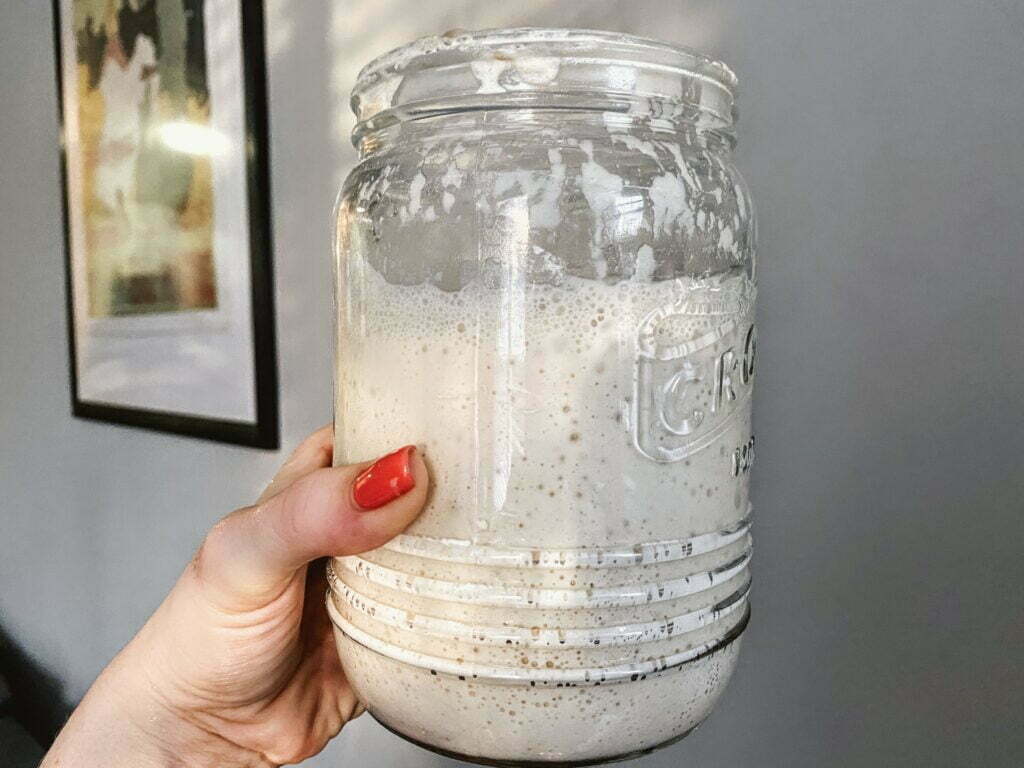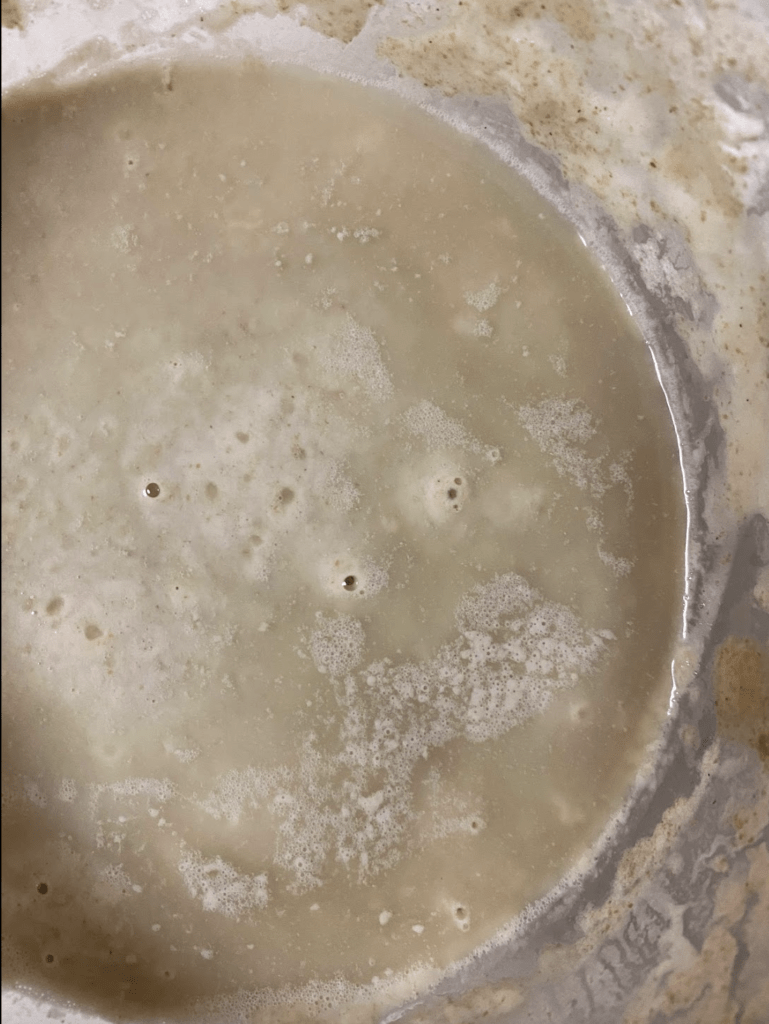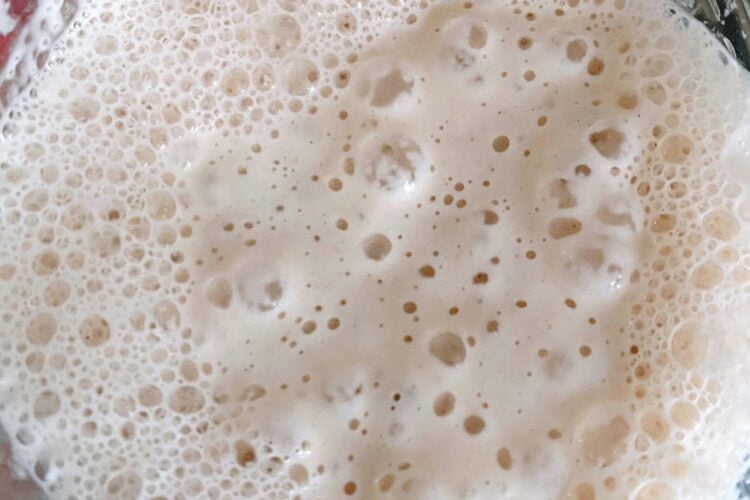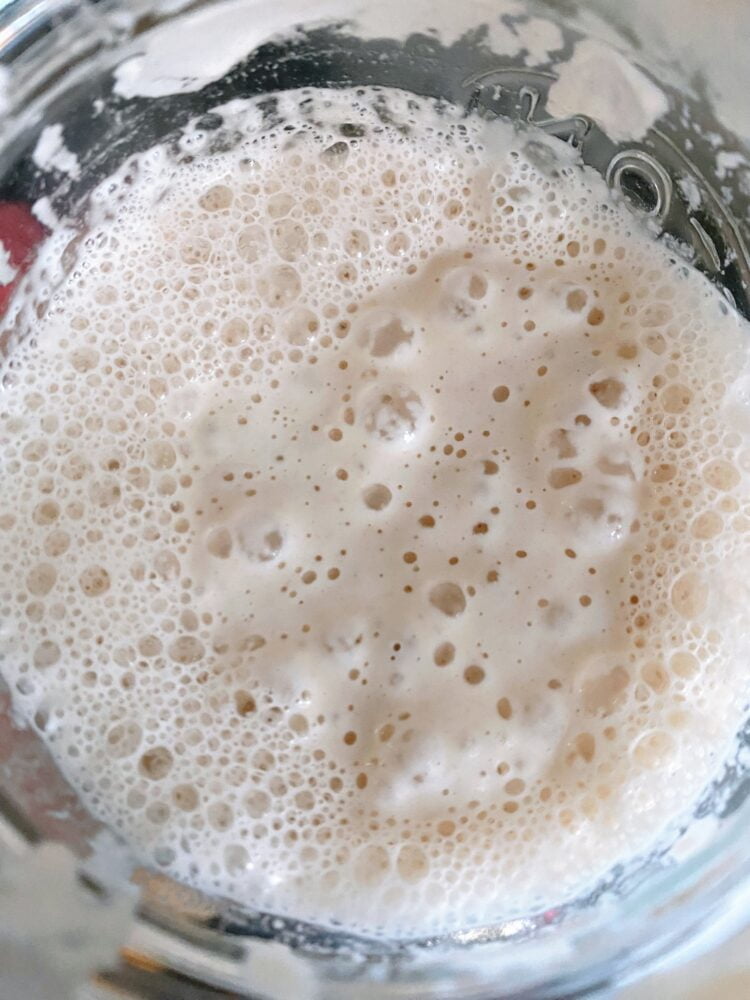Sourdough starter is a simple mixture of flour and water that, when left to ferment, creates a natural leavening agent that can be used to make delicious bread and baked goods. In this article, we will guide you through the process of making your own sourdough starter from scratch, as well as provide tips for feeding and maintaining it. We will also explore the science behind sourdough fermentation and how to troubleshoot common issues that may arise when working with sourdough starter. Whether you are a seasoned bread baker or a beginner looking to try your hand at sourdough, this guide has everything you need to know to get started.
How To make sourdough starter?
Making a sourdough starter is a simple process that involves just a few ingredients and a little bit of patience. Here’s a basic recipe to get you started:
Ingredients:
- 1 cup flour (use a flour that is unbleached and has a higher protein content, like bread flour or whole wheat flour)
- 1/2 cup water (use room temperature, non-chlorinated water)
- Organic grapes or raisins (optional)
Instructions:
- In a clean glass or plastic container, mix the flour and water together until well combined. You can use a whisk or a fork to make sure there are no lumps.
- If you have organic grapes or raisins, add a few of them to the mixture. They contain natural yeasts that can help jumpstart the fermentation process.
- Cover the container loosely with a clean kitchen towel or plastic wrap. You want to let air in, but keep out any dust or other contaminants.
- Store the container in a warm, draft-free place in your kitchen. A temperature between 70°F-85°F (21°C-29°C) is ideal. You can place it on top of the fridge or in a cupboard, for example.
- Every day, for the first few days, stir the mixture with a clean spoon. You should start to see some small bubbles forming on the surface. This is a sign that the fermentation process has started.
- After a few days, you may see a layer of liquid on top of the mixture. This is called hooch and is a byproduct of fermentation. You can either stir it back into the mixture or pour it off. It’s not harmful, but it can change the flavor of your sourdough starter.
- Continue to feed your sourdough starter every day for about a week. To feed it, discard about half of the mixture and then add 1/2 cup flour and 1/4 cup water. Stir well and cover again.
- By the end of the first week, your sourdough starter should be active and ready to use. It should have a pleasant sour smell and be full of bubbles. You can now use it to make sourdough bread or keep it in the fridge and feed it once a week to keep it alive.
Remember, making a sourdough starter can be a bit of trial and error. If your starter doesn’t seem to be doing well, keep trying and don’t give up!

How to make sourdough starter more sour?
To make your sourdough starter more sour, there are a few things you can try:
- Feed it less often: The more often you feed your starter, the less sour it will be. Try feeding your starter once a day or even every other day, instead of twice a day.
- Use a higher proportion of whole wheat flour: Whole wheat flour contains more natural yeasts and bacteria than white flour, which can contribute to a more sour flavor. Try using a higher proportion of whole wheat flour in your starter.
- Ferment it at a cooler temperature: A cooler environment will slow down the fermentation process, which can result in a more sour flavor. Try storing your starter in the fridge or in a cooler part of your kitchen.
- Let it ferment longer: The longer your starter ferments, the more sour it will become. Try leaving your starter out at room temperature for an extra hour or two before you use it.
It’s worth noting that making sourdough bread is a process that takes time and patience. You may need to experiment with different techniques to find the flavor you’re looking for. Also, keep in mind that sourdough starter can be temperamental and may need time to adjust to changes in feeding or temperature.
Where to get sourdough starter?
There are several ways to get sourdough starter:
- Make your own: As I mentioned earlier, making your own sourdough starter is relatively easy and only requires a few simple ingredients. All you need is flour, water, and a little bit of patience. Follow the instructions I provided earlier to make your own sourdough starter at home.
- Get some from a friend: If you know someone who bakes sourdough bread, they may be willing to share some of their sourdough starter with you. Sourdough starter can be divided and shared like a living organism.
- Buy it online: There are several websites where you can purchase sourdough starter, such as King Arthur Flour, Cultures for Health, and Breadtopia. You can also find sourdough starter for sale on sites like Etsy or Amazon.
- Find a local bakery: Some local bakeries may sell or give away their sourdough starter. It’s worth asking around at your local bakeries to see if they can help.
No matter where you get your sourdough starter from, be sure to follow the instructions for feeding and maintaining it carefully to keep it alive and healthy.
Liquid in sourdough starter

The liquid on top of your sourdough starter is called “hooch.” It is a byproduct of the fermentation process and is formed when the yeast and bacteria in the starter consume the flour and water and produce alcohol and lactic acid. Hooch is typically brownish in color and can have a slightly sour smell.
Hooch is not harmful and can be stirred back into the starter, or poured off before feeding your starter. If your sourdough starter has a lot of hooch, it may be an indication that it is hungry and needs to be fed more often or with more flour and water.
It’s important to note that while hooch is a normal part of the sourdough starter process, if your starter smells or looks moldy or has a strange color, it may be contaminated and should be discarded. A healthy sourdough starter should have a pleasant, slightly sour smell, and be bubbly and active.
Is My Sourdough Starter bad?
There are a few signs that can indicate that your sourdough starter has gone bad and should be discarded:
- Mold: If you see any mold growing on your sourdough starter, discard it immediately. Mold can be harmful to your health, and it can also contaminate your baking equipment and environment.
- Foul smell: If your sourdough starter smells foul or rancid, it may be contaminated with harmful bacteria. A healthy sourdough starter should have a slightly sour smell, but it should not be overpowering or unpleasant.
- Discoloration: If your sourdough starter has turned a strange color, such as pink or orange, it may be contaminated with unwanted bacteria. A healthy sourdough starter should be creamy white or beige in color.
- No activity: If your sourdough starter is not bubbling or rising at all, even after being fed, it may be dead. A healthy sourdough starter should be active and bubbly, and should double in size within a few hours of being fed.
If you suspect that your sourdough starter has gone bad, it’s best to err on the side of caution and discard it. You can start a new batch of sourdough starter using the steps I provided earlier.
Why sourdough starter smells like alcohols?
As a result of this fermentation process, the sourdough starter emits a distinctive aroma that is often described as smelling like alcohol. This is because one of the byproducts of the breakdown of the sugars in the flour is ethanol, which is the same type of alcohol found in alcoholic beverages. The longer the starter is allowed to ferment, the more pronounced this alcohol smell can become. However, despite its boozy scent, sourdough starter is not alcoholic and is safe to use in baking.
Can sourdough starter make you sick?
Sourdough starter itself is generally safe to consume and is not likely to make you sick, as the acidic environment created during the fermentation process of sourdough can inhibit the growth of harmful bacteria. However, it’s important to practice good food safety when working with sourdough starter to minimize the risk of contamination and foodborne illness.
One potential risk when working with sourdough starter is the presence of mold or harmful bacteria, which can cause illness if ingested. This can happen if the starter is not properly maintained, or if it is contaminated during the baking process. To minimize the risk of contamination, it’s important to always use clean utensils and containers when working with sourdough starter, and to discard any starter that shows signs of mold or an off smell.
Additionally, some people may be sensitive or allergic to the components of the flour used to make sourdough starter. If you have a known allergy or sensitivity to wheat or gluten, for example, it’s important to avoid working with or consuming sourdough starter made with those ingredients.
In general, when working with sourdough starter, it’s important to practice good food safety and hygiene practices, and to pay attention to any changes in the appearance or smell of the starter, which could indicate a problem. If you have any concerns or experience any adverse symptoms after consuming sourdough bread or starter, it’s best to consult a medical professional.
How much sourdough starter to keep?
The amount of sourdough starter you should discard depends on the recipe you are using and how much starter you need to maintain. When you feed your sourdough starter, you typically discard a portion of the starter before adding fresh flour and water. The general rule of thumb is to discard at least half of the starter before each feeding, but you can adjust this amount based on your needs.
If you are new to maintaining a sourdough starter, you can start with a small amount, such as 50 grams of starter, and build it up gradually over time as you bake more bread. For example, if you are feeding your starter with 50 grams of flour and 50 grams of water, you can discard 50 grams of the starter and add 50 grams of fresh flour and 50 grams of water to the remaining starter.
It’s important to note that sourdough starter is a living organism and can be temperamental, so it may take some trial and error to figure out the right amount of starter to discard and how often to feed it. As you become more experienced with maintaining a sourdough starter, you will develop a better sense of what works best for you and your baking routine.
Sourdough Starter: How to Make, Feed, and Use Your Own Starter for Perfect Bread Every Time
Difficulty: EasyIngredients
1 cup of flour
1/2 cup water (use room temperature, non-chlorinated water)
Grapes or Raisins (optional)
Directions
- Mix flour and water until well combined (make sure there are no lumps)
- If you have organic grapes or raisins, add a few of them to the mixture. They contain natural yeasts that can help jumpstart the fermentation process.
- Cover the container loosely with a clean kitchen towel or plastic wrap and store in a warm, draft free place somewhere in the kitchen. A temperature between 70°F-85°F (21°C-29°C) is ideal.
- Every day, for the first few days(1-2), stir the mixture with a clean spoon. You should start to see some small bubbles forming on the surface. This is a good sign, that mean fermentation process has started.
- After about 2 or 3 days, after you noticed small bubbles, we need to feed our starter. Discard about half of the mixture and then add 1/2 cup flour and 1/4 cup water. Stir well and cover again.
- Feed the starter again in 1 or 2 days. By the end of the first week, your sourdough starter should be active and ready to use. It should have a pleasant sour smell and be full of bubbles. You can now use it to make sourdough bread or keep it in the fridge and feed it once a week to keep it alive.
- Keep repeating the “discard and feed” cycle to keep the starter alive.
Notes
- Remember, making a sourdough starter can be a bit of trial and error. If your starter doesn’t seem to be doing well, keep trying and don’t give up!
- After you have a well established starter, and you don’t feel like feeding it every day, you can store it in the fridge. In the fridge you will need to feed the starter about once a week.







[…] bread is made using a sourdough starter, which is a mixture of flour and water that has been fermented by naturally occurring bacteria and […]
[…] How to make sourdough starter […]
[…] if all that didn’t work, you can always try to create sourdough starter from scratch or buy […]
[…] difference between an active sourdough starter and a not active one lies in their fermentation activity and ability to leaven bread. Here’s […]